Microbeam X-Ray Investigation of the Structural Transition from Circularly Banded to Ringless Dendritic Assemblies in Poly(Butylene Adipate) Through Dilution with Poly(Ethylene Oxide)
Abstract
1. Introduction
2. Experimental
2.1. Materials and Preparation
2.2. Apparatus
3. Results and Discussion
3.1. Assembly Patterns in Highly Diluted PBA/PEO Blends
3.2. Assembly of the Interior vs. Top Surface of Circularly-Banded PBA Crystal Aggregates
3.3. General Features of Periodically Circular Assembly as Viewed from Interiors
3.4. Micro- to Nano-Views on Assembly in Straight-Dendrite PBA Aggregates
3.5. Synchrotron Microbeam X-Ray Analysis on Straight Dendritic vs. Circular-Banded Zones
3.6. Iridescence as a Proof for Grating Assembly in Straight Dendrites vs. Circularly Banded PBA
4. Conclusions
Supplementary Materials
Author Contributions
Funding
Data Availability Statement
Acknowledgments
Conflicts of Interest
References
- Yang, F.; Yin, Y.J.; He, B.; Fan, Q.S. Fractal Growth Kinematics Abstracted from Snowflakes: Topological Evolution. Appl. Math. Mech. 2015, 36, 243–264. [Google Scholar] [CrossRef]
- Yin, Y.; Yang, F.; Fan, Q. Growth Kinematics of Fractal Super Snowflakes. Chin. Sci. Bull. 2010, 55, 573–580. [Google Scholar] [CrossRef]
- Yin, Y.; He, B.; Yang, F.; Fan, Q. Centroid Evolution Theorem Induced from Fractal Super Fibers or Fractal Super Snowflakes. Int. J. Nonlinear Sci. Numer. Simul. 2009, 10, 805–810. [Google Scholar] [CrossRef]
- Dong, Y.; Lam, J.W.Y.; Qin, A.; Sun, J.; Liu, J.; Li, Z.; Sun, J.; Sung, H.H.Y.; Williams, I.D.; Kwok, H.S.; et al. Aggregation-Induced and Crystallization-Enhanced Emissions of 1,2-Diphenyl-3,4-Bis(Diphenylmethylene)-1-Cyclobutene. Chem. Commun. 2007, 31, 3255. [Google Scholar] [CrossRef]
- Hsiao, T.-S.; Huang, P.-C.; Lin, L.-Y.; Yang, D.-J.; Hong, J.-L. Crystallization-Promoted Emission Enhancement of Poly(L-Lactide) Containing a Fluorescent Salicylideneazine Center with Aggregation-Enhanced Emission Properties. Polym. Chem. 2015, 6, 2264–2273. [Google Scholar] [CrossRef]
- Ye, L.; Qiu, J.; Wu, T.; Shi, X.; Li, Y. Banded Spherulite Templated Three-Dimensional Interpenetrated Nanoporous Materials. RSC Adv. 2014, 4, 43351–43356. [Google Scholar] [CrossRef]
- Keller, A.; Sawada, S. On the Interior Morphology of Bulk Polyethylene. Makromol. Chem. 1964, 74, 190–221. [Google Scholar] [CrossRef]
- Nguyen Tri, P.; Prud’Homme, R.E. Crystallization and Segregation Behavior at the Submicrometer Scale of PCL/PEG Blends. Macromolecules 2018, 51, 7266–7273. [Google Scholar] [CrossRef]
- Keller, A. The Spherulitic Structure of Crystalline Polymers. Part II. The Problem of Molecular Orientation in Polymer Spherulites. J. Polym. Sci. 1955, 17, 351–364. [Google Scholar] [CrossRef]
- Keller, A. The Spherulitic Structure of Crystalline Polymers. Part I. Investigations with the Polarizing Microscope. J. Polym. Sci. 1955, 17, 291–308. [Google Scholar] [CrossRef]
- Keith, H.D.; Padden, F.J. A Discussion of Spherulitic Crystallization and Spherulitic Morphology in High Polymers. Polymer 1986, 27, 1463–1471. [Google Scholar] [CrossRef]
- Ono, R.; Atarashi, H.; Yamazaki, S.; Kimura, K. Molecular Weight Dependence of the Growth Rate of Spherulite of Cyclic Poly(ε-Caprolactone) Polymerized by Ring Expansion Reaction. Polymer 2020, 194, 122403. [Google Scholar] [CrossRef]
- Bassett, D.C.; Keith, H.D. Electron Microscopy and Spherulitic Organization in Polymers. Crit. Rev. Solid State Mater. Sci. 1984, 12, 97–163. [Google Scholar] [CrossRef]
- Crist, B.; Schultz, J.M. Polymer Spherulites: A Critical Review. Prog. Polym. Sci. 2016, 56, 1–63. [Google Scholar] [CrossRef]
- Bassett, D.C. Polymer Spherulites: A Modern Assessment. J. Macromol. Sci. Part B 2003, 42, 227–256. [Google Scholar] [CrossRef]
- Keith, H.D.; Padden, F.J. The Optical Behavior of Spherulites in Crystalline Polymers. Part II. The Growth and Structure of the Spherulites. J. Polym. Sci. 1959, 39, 123–138. [Google Scholar] [CrossRef]
- Keith, H.D.; Padden, F.J. The Optical Behavior of Spherulites in Crystalline Polymers. Part I. Calculation of Theoretical Extinction Patterns in Spherulites with Twisting Crystalline Orientation. J. Polym. Sci. 1959, 39, 101–122. [Google Scholar] [CrossRef]
- Tanaka, H.; Nishi, T. Local Phase Separation at the Growth Front of a Polymer Spherulite during Crystallization and Nonlinear Spherulitic Growth in a Polymer Mixture with a Phase Diagram. Phys. Rev. A 1989, 39, 783–794. [Google Scholar] [CrossRef]
- Keith, H.D. Banding in Spherulites: Two Recurring Topics. Polymer 2001, 42, 09987–09993. [Google Scholar] [CrossRef]
- Woo, E.M.; Nurkhamidah, S.; Chen, Y.F. Surface and Interior Views on Origins of Two Types of Banded Spherulites in Poly(Nonamethylene Terephthalate). Phys. Chem. Chem. Phys. 2011, 13, 17841–17851. [Google Scholar] [CrossRef]
- Woo, E.M. Banded Crystalline Spherulites in Polymers and Organic Compounds: Interior Lamellar Structures Correlating with Top-Surface Topology. J. Adv. Chem. Eng. 2015, 5, 1–6. [Google Scholar] [CrossRef]
- Wang, T.; Wang, H.; Li, H.; Gan, Z.; Yan, S. Banded Spherulitic Structures of Poly(Ethylene Adipate), Poly(Butylene Succinate) and in Their Blends. Phys. Chem. Chem. Phys. 2009, 11, 1619–1627. [Google Scholar] [CrossRef]
- Takayanagi, M.; Yamashita, T. Growth Rate and Structure of Spherulite in Fractionated Poly(Ethylene Adipate). J. Polym. Sci. 1956, 22, 552–555. [Google Scholar] [CrossRef]
- Kim, M.-N.; Kim, K.-H.; Jin, H.-J.; Park, J.-K.; Yoon, J.-S. Biodegradability of Ethyl and N-Octyl Branched Poly(Ethylene Adipate) and Poly(Butylene Succinate). Eur. Polym. J. 2001, 37, 1843–1847. [Google Scholar] [CrossRef]
- Frömsdorf, A.; Woo, E.M.; Lee, L.T.; Chen, Y.F.; Förster, S. Atomic Force Microscopy Characterization and Interpretation of Thin-Film Poly(Butylene Adipate) Spherulites with Ring Bands. Macromol. Rapid Commun. 2008, 29, 1322–1328. [Google Scholar] [CrossRef]
- Hoffman, J.D. Regime III Crystallization in Melt-Crystallized Polymers: The Variable Cluster Model of Chain Folding. Polymer 1983, 24, 3–26. [Google Scholar] [CrossRef]
- Bassett, D.C. Developments in Crystalline Polymers—1; Bassett, D.C., Ed.; Springer: Dordrecht, The Netherlands, 1982; ISBN 978-94-009-7345-9. [Google Scholar]
- Yang, S.-G.; Wei, Z.-Z.; Cseh, L.; Kazemi, P.; Zeng, X.; Xie, H.-J.; Saba, H.; Ungar, G. Bowls, Vases and Goblets—The Microcrockery of Polymer and Nanocomposite Morphology Revealed by Two-Photon Optical Tomography. Nat. Commun. 2021, 12, 5054. [Google Scholar] [CrossRef]
- Ikehara, T.; Kataoka, T. Relation between the Helical Twist and S-Shaped Cross Section of the Lamellar Crystals of Polyethylene. Sci. Rep. 2013, 3, 1444. [Google Scholar] [CrossRef]
- Fujiwara, Y. The Superstructure of Melt-crystallized Polyethylene. I. Screwlike Orientation of Unit Cell in Polyethylene Spherulites with Periodic Extinction Rings. J. Appl. Polym. Sci. 1960, 4, 10–15. [Google Scholar] [CrossRef]
- Keith, H.D.; Padden, F.J. Ringed Spherulites in Polyethylene. J. Polym. Sci. 1958, 31, 415–421. [Google Scholar] [CrossRef]
- Yakovlev, S.; Downing, K.H.; Brant, P. Cross Hatched Structure of Polyethylene Spherulites. Polym. Cryst. 2021, 4, e10174. [Google Scholar] [CrossRef]
- Bassett, D.C.; Hodge, A.M. On Lamellar Organization in Certain Polyethylene Spherulites. Polymer 1978, 19, 469–472. [Google Scholar] [CrossRef]
- Toda, A.; Taguchi, K.; Hikosaka, M.; Kajioka, H. Branching and Higher Order Structure in Banded Polyethylene Spherulites. Macromolcules 2008, 41, 2484–2493. [Google Scholar] [CrossRef]
- Toda, A.; Taguchi, K.; Kajioka, H. Instability-Driven Branching of Lamellar Crystals in Polyethylene Spherulites. Macromolecules 2008, 41, 7506–7512. [Google Scholar] [CrossRef]
- Willems, J.; Willems, I. Oriented Overgrowth of Paraffin Wax Crystals on Spherulites of Polyethylene. Nature 1956, 178, 429–430. [Google Scholar] [CrossRef]
- Watson, J.D.; Crick, F.H.C. Molecular Structure of Nucleic Acids: A Structure for Deoxyribose Nucleic Acid. Nature 1953, 171, 737–738. [Google Scholar] [CrossRef]
- Thompson, J.; Braun, G.; Tierney, D.; Wessels, L.; Schmitzer, H.; Rossa, B.; Wagner, H.P.; Dultz, W. Rosalind Franklin’s X-Ray Photo of DNA as an Undergraduate Optical Diffraction Experiment. Am. J. Phys. 2018, 86, 95–104. [Google Scholar] [CrossRef]
- Klug, A. Rosalind Franklin and the Discovery of the Structure of DNA. Nature 1968, 219, 808–844. [Google Scholar] [CrossRef]
- Schultz, J.M.; Kinloch, D.R. Transverse Screw Dislocations: A Source of Twist in Crystalline Polymer Ribbons. Polymer 1969, 10, 271–278. [Google Scholar] [CrossRef]
- Eshelby, J.D. Screw Dislocations in Thin Rods. J. Appl. Phys. 1953, 24, 176–179. [Google Scholar] [CrossRef]
- Toda, A.; Taguchi, K.; Hikosaka, M.; Kajioka, H. Branching and Higher Order Structure in Banded Poly(Vinylidene Fluoride) Spherulites. Polym. J. 2008, 40, 905–909. [Google Scholar] [CrossRef]
- Lotz, B.; Cheng, S.Z.D. A Critical Assessment of Unbalanced Surface Stresses as the Mechanical Origin of Twisting and Scrolling of Polymer Crystals. Polymer 2005, 46, 577–610. [Google Scholar] [CrossRef]
- Ye, H.M.; Xu, J.; Guo, B.H.; Iwata, T. Left- or Right-Handed Lamellar Twists in Poly[(R)-3-Hydroxyvalerate] Banded Spherulite: Dependence on Growth Axis. Macromolecules 2009, 42, 694–701. [Google Scholar] [CrossRef]
- Bassett, D.C. A Critical Assessment of Unbalanced Surface Stresses: Some Complementary Considerations. Polymer 2006, 47, 3263–3266. [Google Scholar] [CrossRef]
- Taguchi, K.; Miyamoto, Y.; Miyaji, H.; Izumi, K. Undulation of Lamellar Crystals of Polymers by Surface Stresses. Macromolecules 2003, 36, 5208–5213. [Google Scholar] [CrossRef]
- Chuah, H.H. Intrinsic Birefringence of Poly(Trimethylene Terephthalate). J. Polym. Sci. B Polym. Phys. 2002, 40, 1513–1520. [Google Scholar] [CrossRef]
- Yun, J.H.; Kuboyama, K.; Ougizawa, T. High Birefringence of Poly(Trimethylene Terephthalate) Spherulite. Polymer 2006, 47, 1715–1721. [Google Scholar] [CrossRef]
- Tu, C.H.; Woo, E.M.; Lugito, G. Structured Growth from Sheaf-like Nuclei to Highly Asymmetric Morphology in Poly(Nonamethylene Terephthalate). RSC Adv. 2017, 7, 47614–47618. [Google Scholar] [CrossRef]
- Woo, E.M.; Lugito, G. Origins of Periodic Bands in Polymer Spherulites. Eur. Polym. J. 2015, 71, 27–60. [Google Scholar] [CrossRef]
- Ichikawa, Y.; Mizukoshi, T. Bionolle (Polybutylenesuccinate). In Synthetic Biodegradable Polymers; Springer: Berlin/Heidelberg, Germany, 2011; pp. 285–313. [Google Scholar]
- Gan, Z.; Abe, H.; Doi, Y. Temperature-Induced Polymorphic Crystals of Poly(Butylene Adipate). Macromol. Chem. Phys. 2002, 203, 2369–2374. [Google Scholar] [CrossRef]
- Song, T.; Shi, W. Polymer Crystallization and Optical Birefringence Modulated by Solvent Evaporation in Sessile Droplets. Polymer 2024, 307, 127287. [Google Scholar] [CrossRef]
- Song, T.; Wu, X.; Xu, J.; Ye, H.; Shi, W. Two-Level Optical Birefringence Created by Evaporation-Induced Polymer Crystallization in Sessile Droplets. Macromolecules 2023, 56, 707–718. [Google Scholar] [CrossRef]
- Li, H.; Nagarajan, S.; Chuang, W.; Tsai, Y.; Woo, E.M. Microscopic and Small-/Wide-Angle Microbeam X-Ray Analyses on Dendritic Crystals in Poly(Butylene Succinate). Macromolecules 2023, 56, 1471–1480. [Google Scholar] [CrossRef]
- Rahmayanti, W.; Nagarajan, S.; Sun, Y.-S.; Woo, E.M. Iridescent Features Correlating with Periodic Assemblies in Custom-Crystallized Arylate Polyesters. Int. J. Mol. Sci. 2023, 24, 15538. [Google Scholar] [CrossRef]
- Hao, M.-H.; Nagarajan, S.; Woo, E.M. Probing the Nano-Assembly Leading to Periodic Gratings in Poly(p-Dioxanone). Nanomaterials 2023, 13, 2665. [Google Scholar] [CrossRef]
- Liu, J.; Ye, H.M.; Xu, J.; Guo, B.H. Formation of Ring-Banded Spherulites of α and β Modifications in Poly(Butylene Adipate). Polymer 2011, 52, 4619–4630. [Google Scholar] [CrossRef]
- Wang, J.; De Jeu, W.H.; Müller, P.; Möller, M.; Mourran, A. Thin Film Structure of Block Copolymer-Surfactant Complexes: Strongly Ionic Bonding Polymer Systems. Macromolecules 2012, 45, 974–985. [Google Scholar] [CrossRef]
- Wu, M.C.; Woo, E.M. Effects of α-Form or β-Form Nuclei on Polymorphic Crystalline Morphology of Poly(Butylene Adipate). Polym. Int. 2005, 54, 1681–1688. [Google Scholar] [CrossRef]
- Lugito, G.; Woo, E.M. Intertwining Lamellar Assembly in Porous Spherulites Composed of Two Ring-Banded Poly(Ethylene Adipate) and Poly(Butylene Adipate). Soft Matter 2015, 11, 908–917. [Google Scholar] [CrossRef]
- Nagarajan, S.; Woo, E.M.; Su, C.; Yang, C. Microstructural Periodic Arrays in Poly(Butylene Adipate) Featured with Photonic Crystal Aggregates. Macromol. Rapid Commun. 2021, 42, 2100202. [Google Scholar] [CrossRef]
- Chang, C.-I.; Woo, E.M.; Nagarajan, S. Grating Assembly Dissected in Periodic Bands of Poly(Butylene Adipate) Modulated with Poly(Ethylene Oxide). Polymers 2022, 14, 4781. [Google Scholar] [CrossRef]
- Minke, R.; Blackwell, J. Single Crystals of Poly(Tetramethylene Adipate). J. Macromol. Sci. Part B 1980, 18, 233–255. [Google Scholar] [CrossRef]
- Minke, R.; Blackwell, J. Polymorphic Structures of Poly(Tetramethylene Adipate). J. Macromol. Sci. Part B 1979, 16, 407–417. [Google Scholar] [CrossRef]
- Moonstone. Phil. Mag. 27. Available online: https://www.britannica.com/topic/The-Moonstone (accessed on 24 July 2025).
- Chuang, T.-C.; Nagarajan, S.; Su, C.-C.; Lee, L.-T.; Woo, E.M. Universality in Interior Periodic Assembly of Banded D-(−)-Poly(3-Hydroxybutyrate) Justified with the Iridescence Test. CrystEngComm 2024, 26, 1209–1218. [Google Scholar] [CrossRef]
- Rahmayanti, W.; Nagarajan, S.; Su, C.; Nurkhamidah, S.; Lee, L.; Woo, E.M. Nano-Assembly Architectures and Structural Iridescence in Poly(3-Hydroxybutyric Acid-Co-3-Hydroxyvaleric). ACS Appl. Polym. Mater. 2024, 6, 6229–6240. [Google Scholar] [CrossRef]
- Liu, Y.; Shigley, J.E.; Hurwit, K.N. Iridescence Color of a Shell of the Mollusk Pinctada Margaritifera Caused by Diffraction. Opt. Express 1999, 4, 177–182. [Google Scholar] [CrossRef]
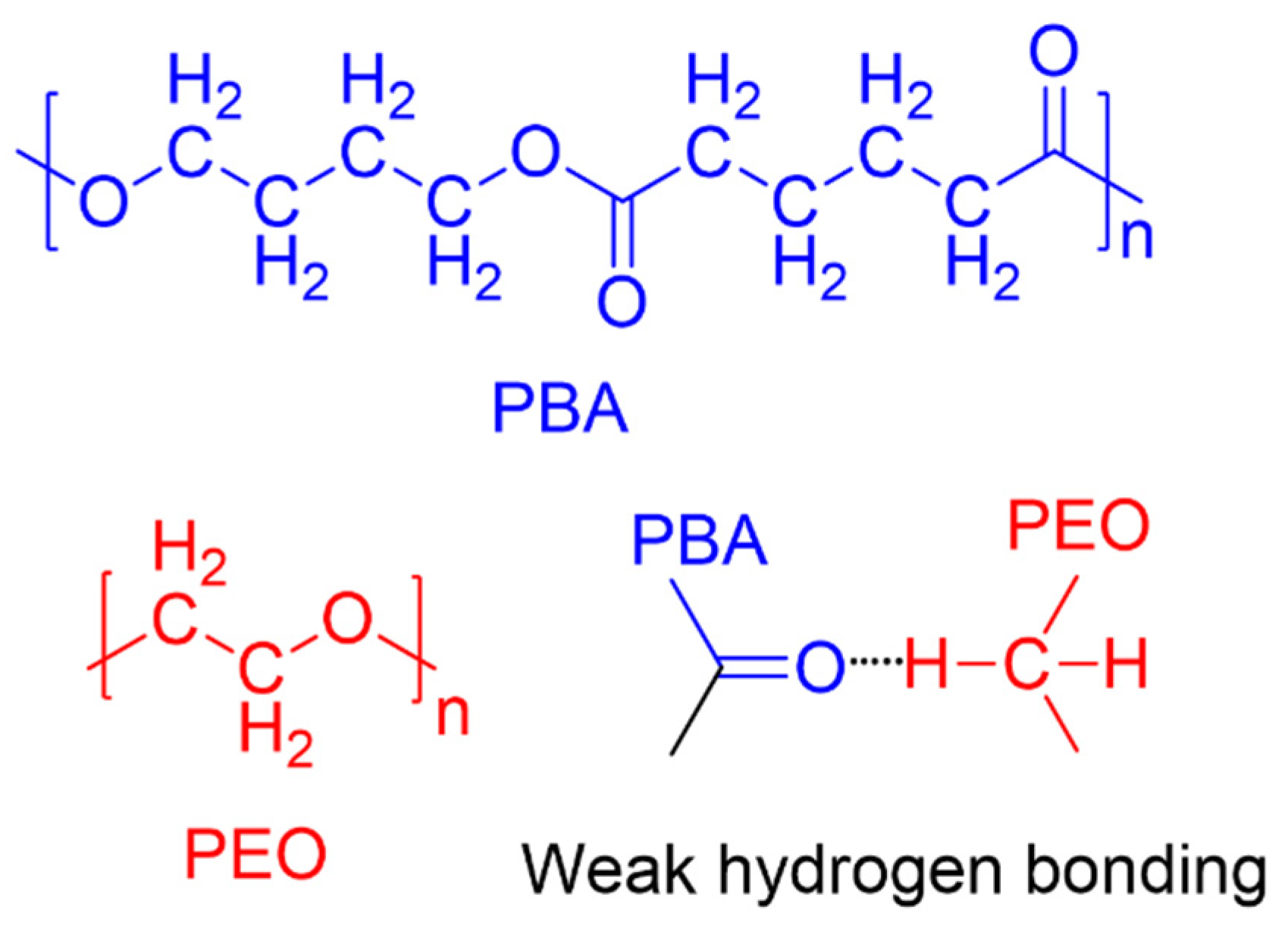
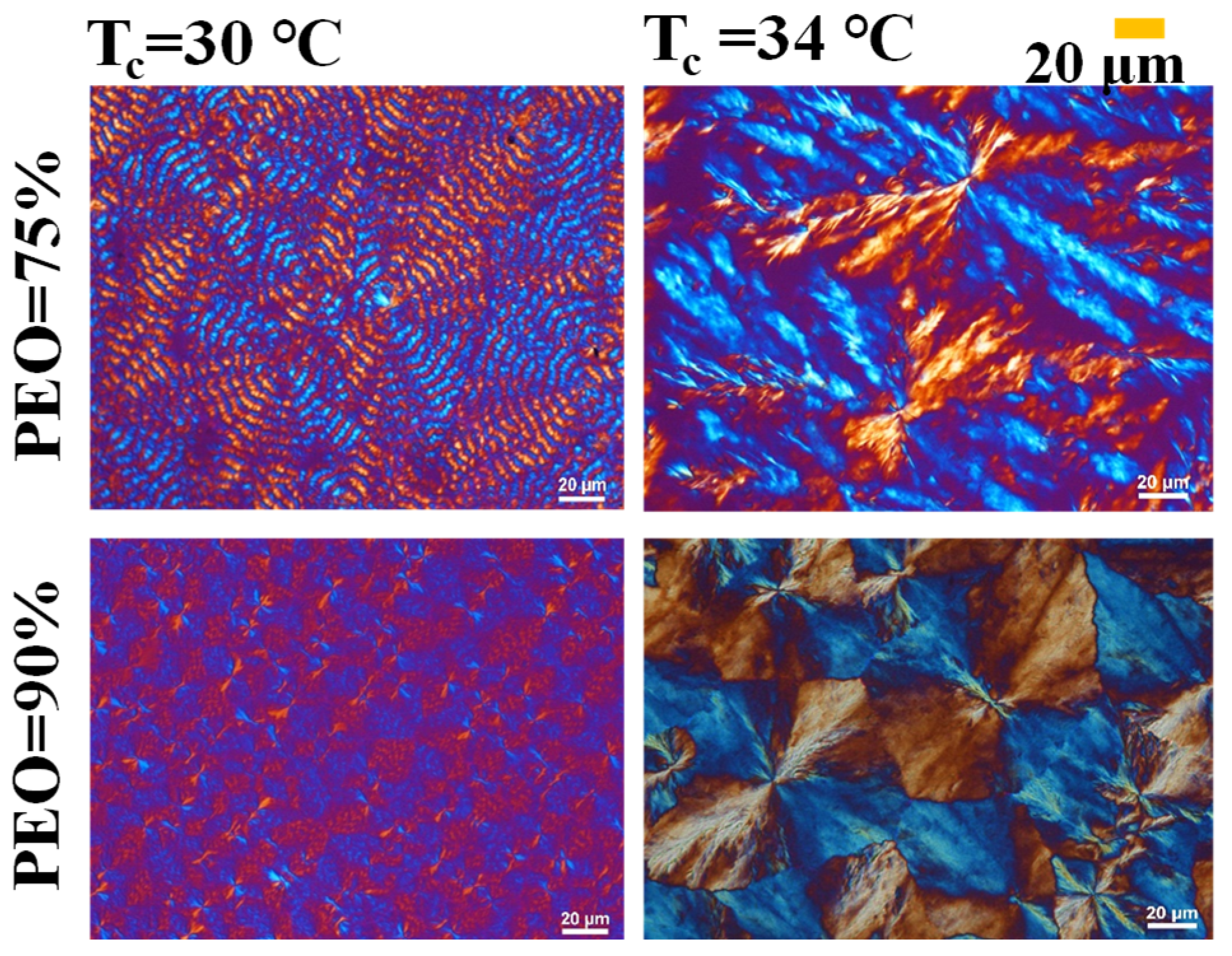
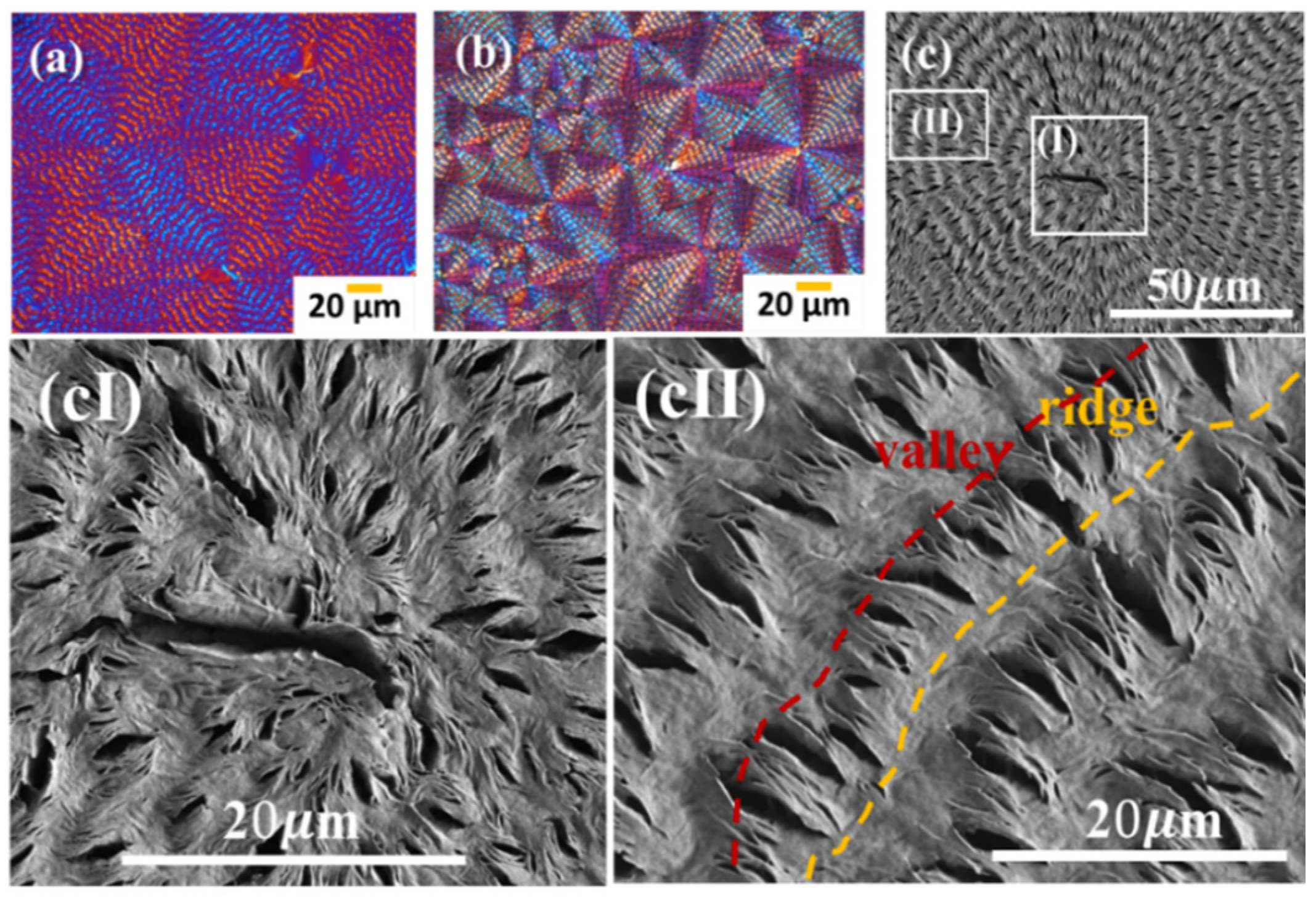
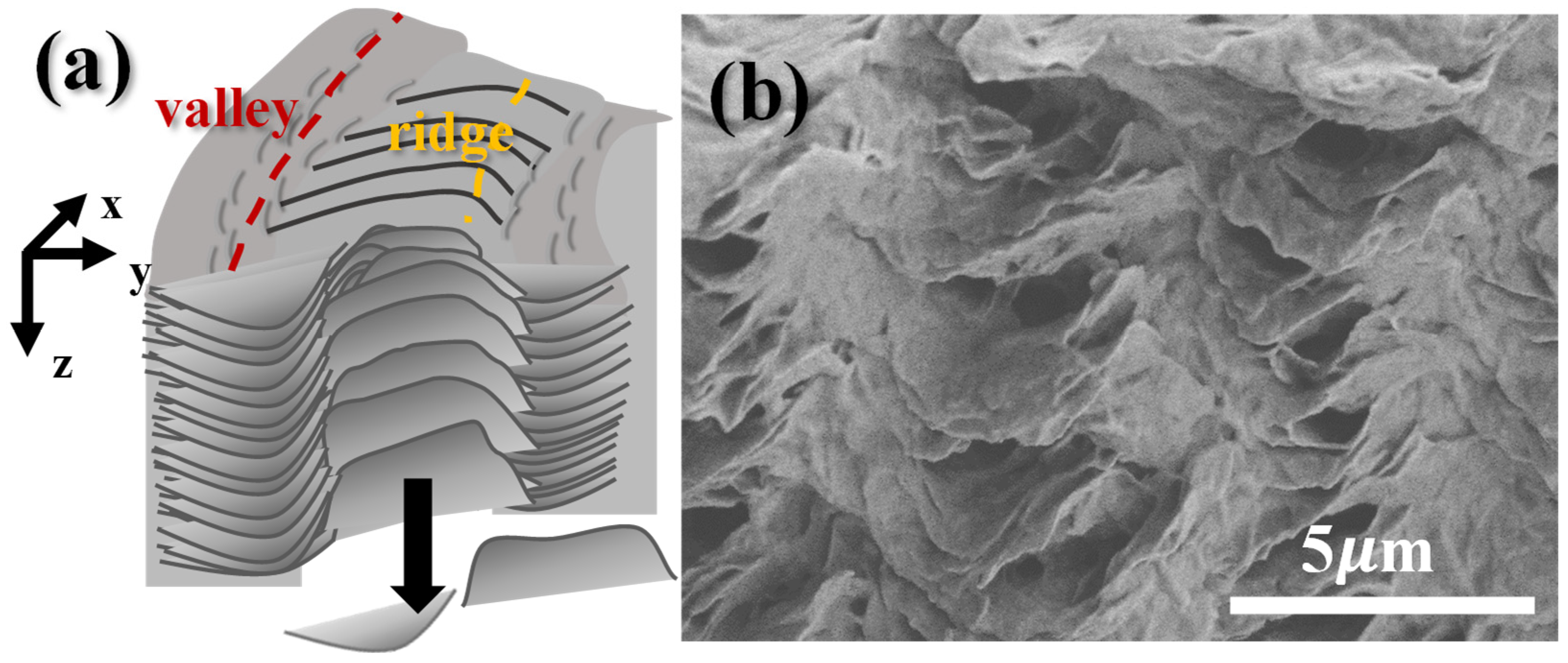

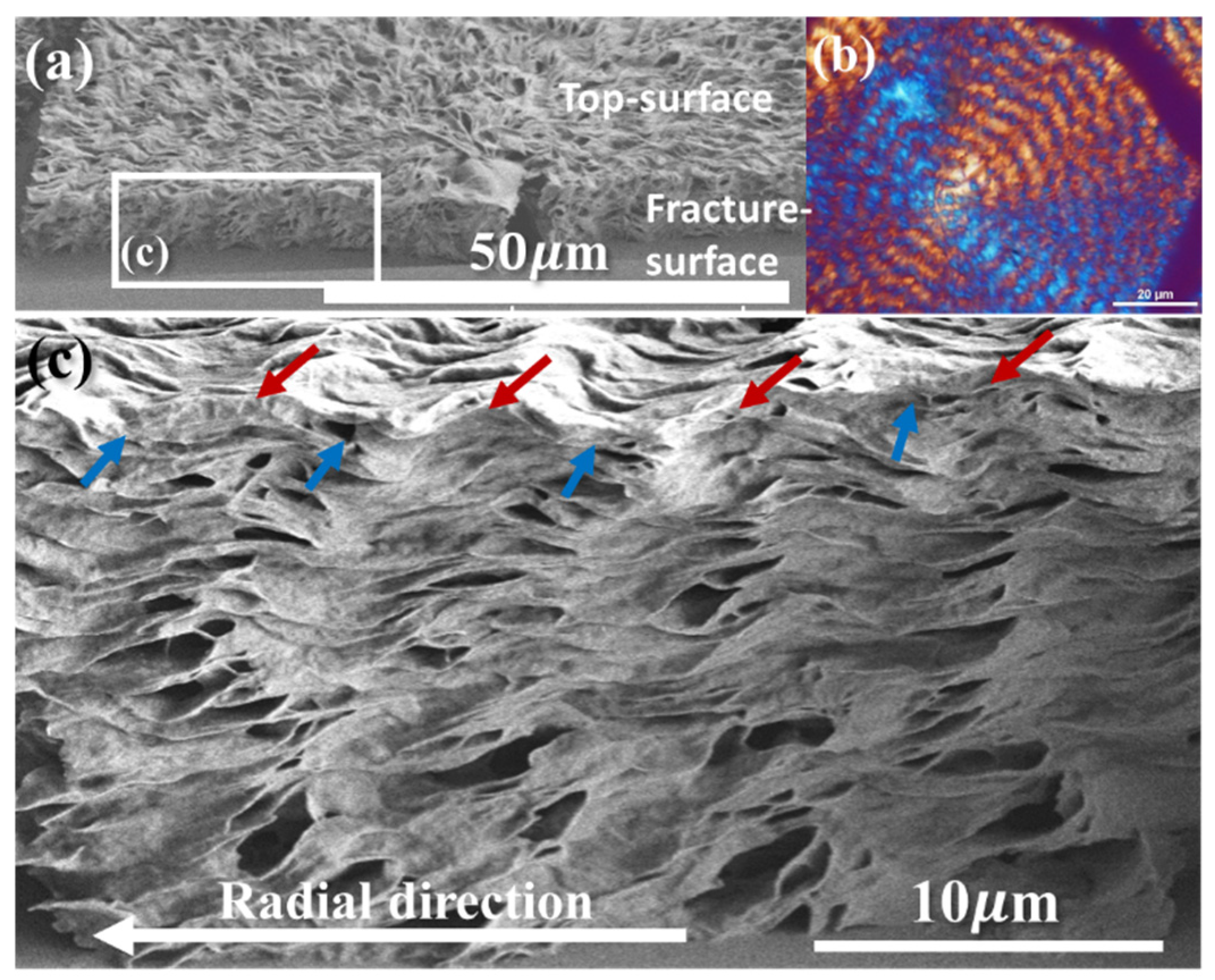

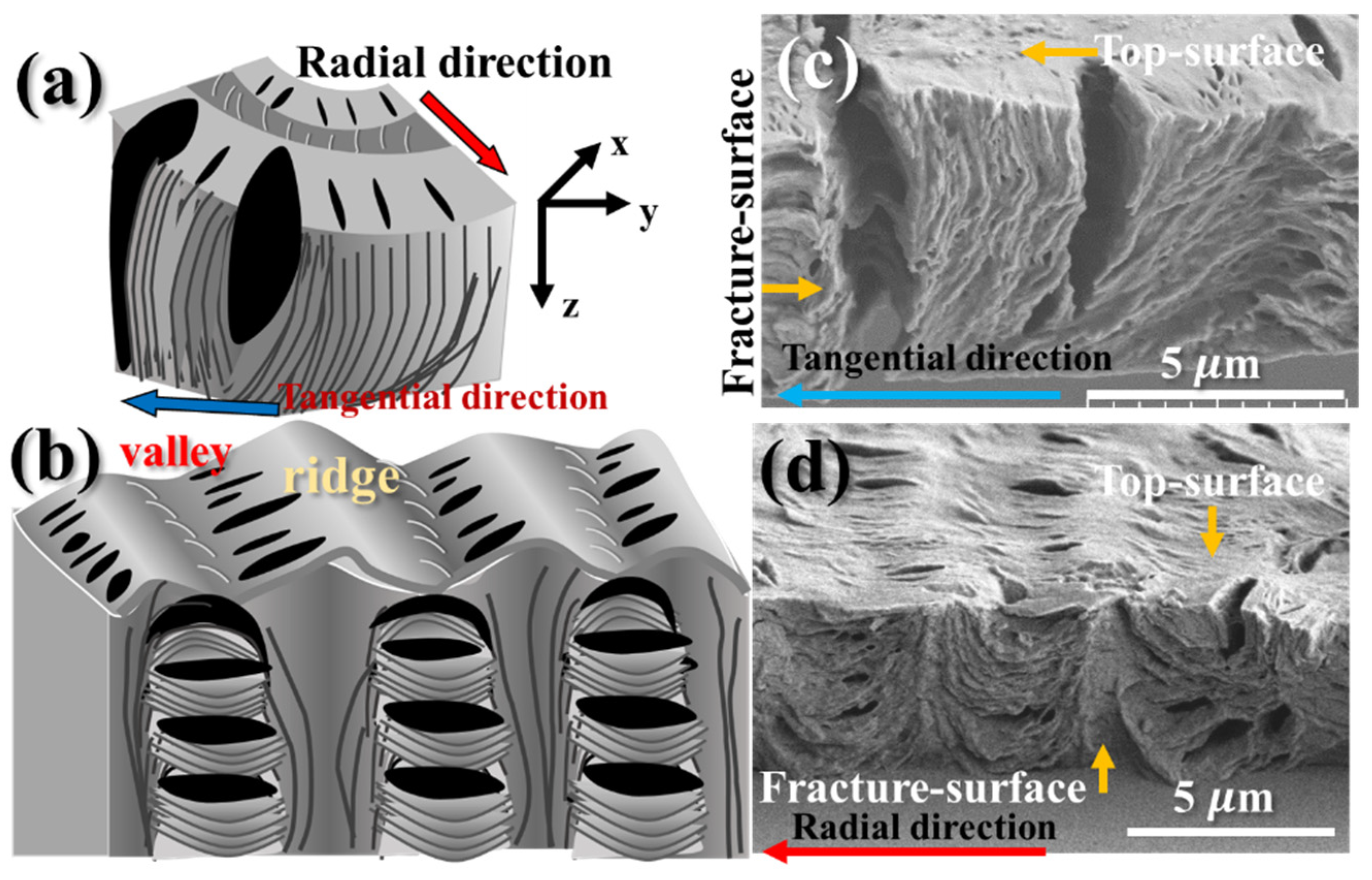
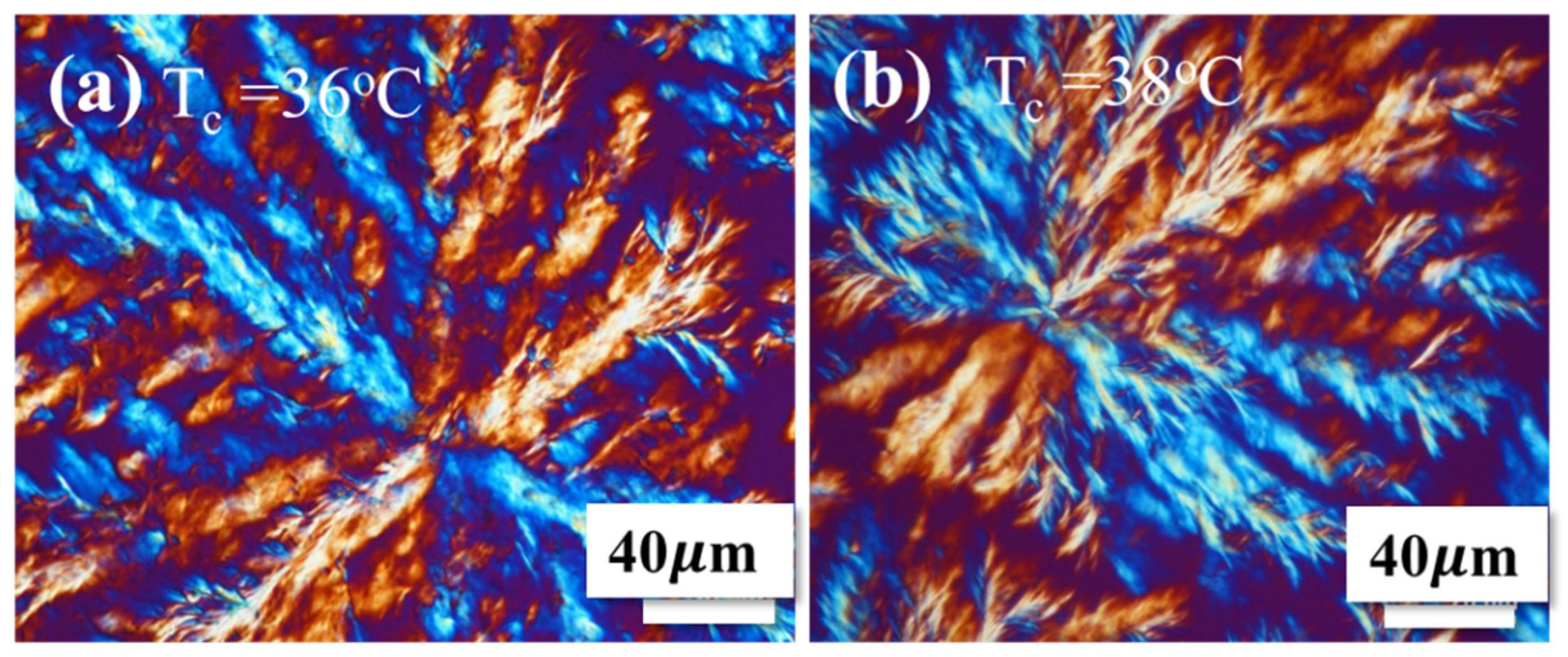
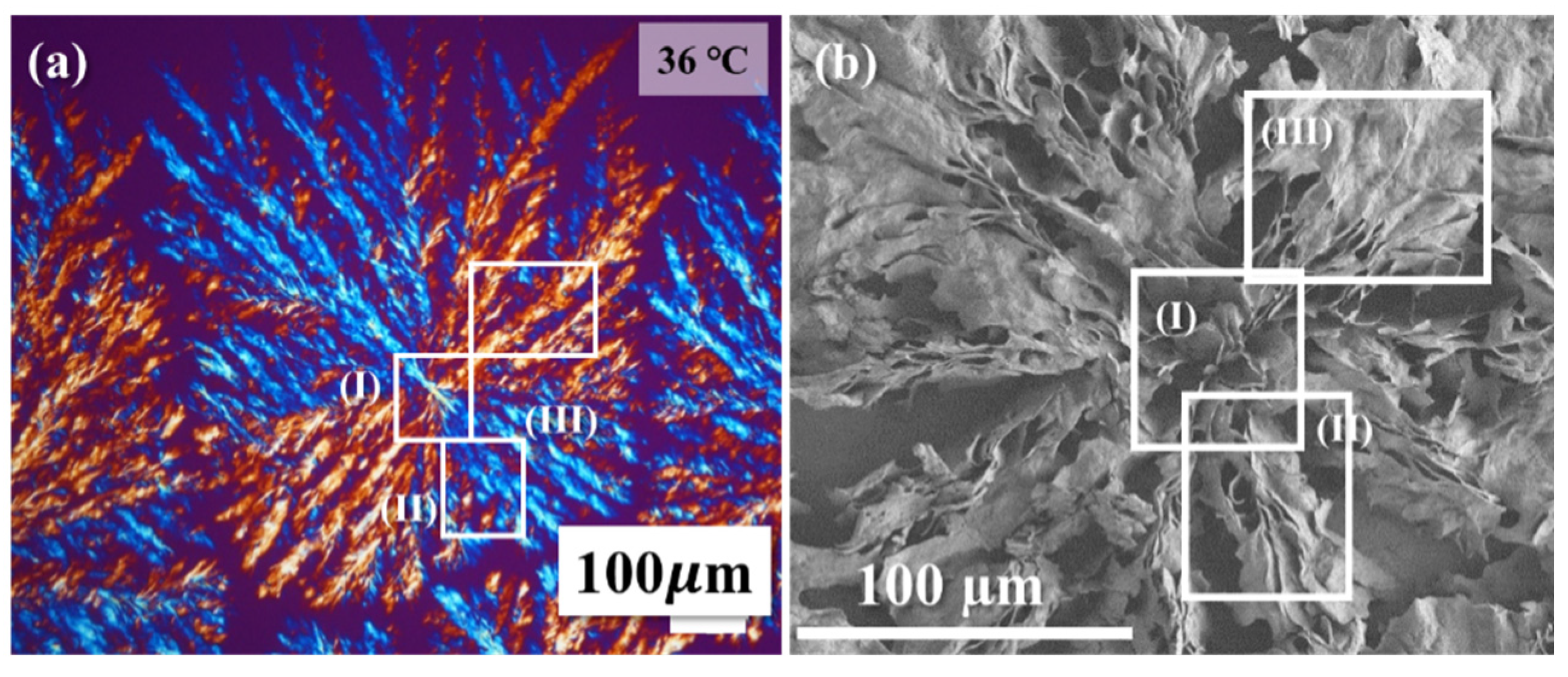
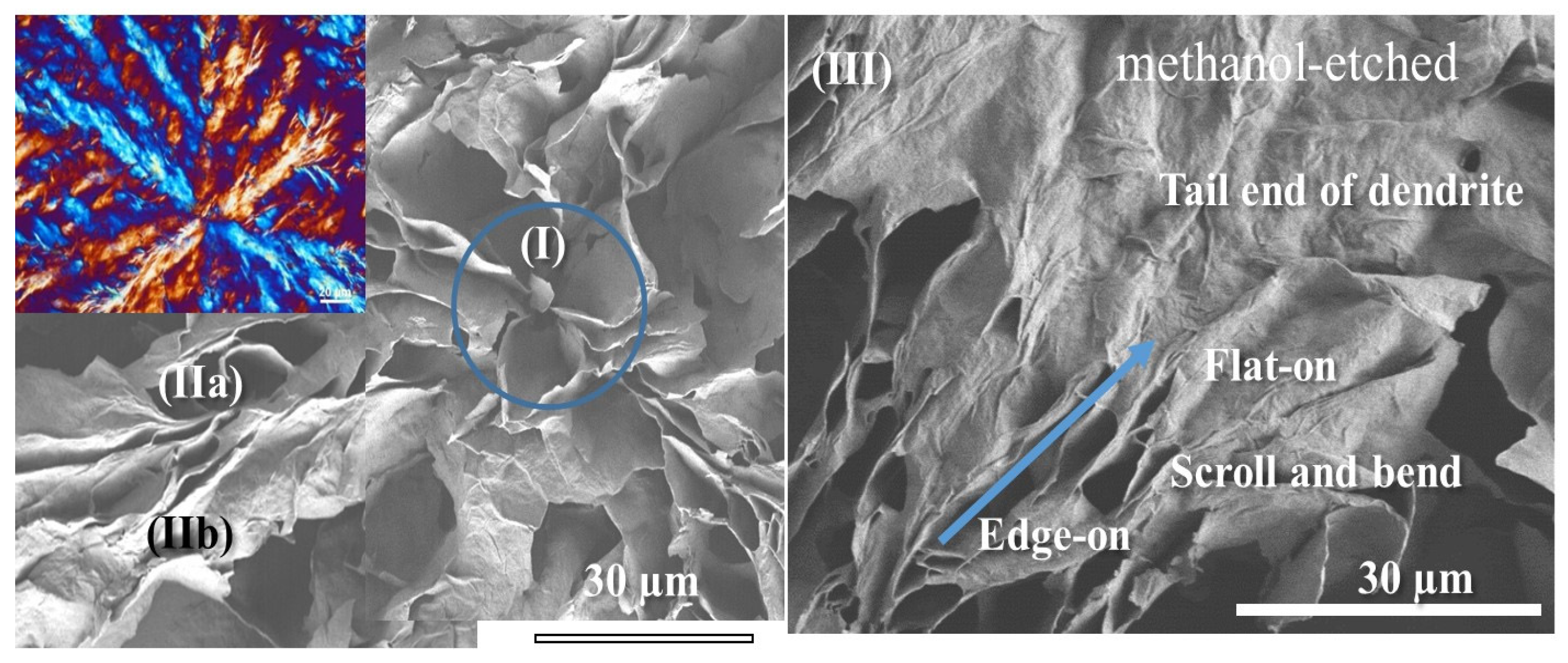
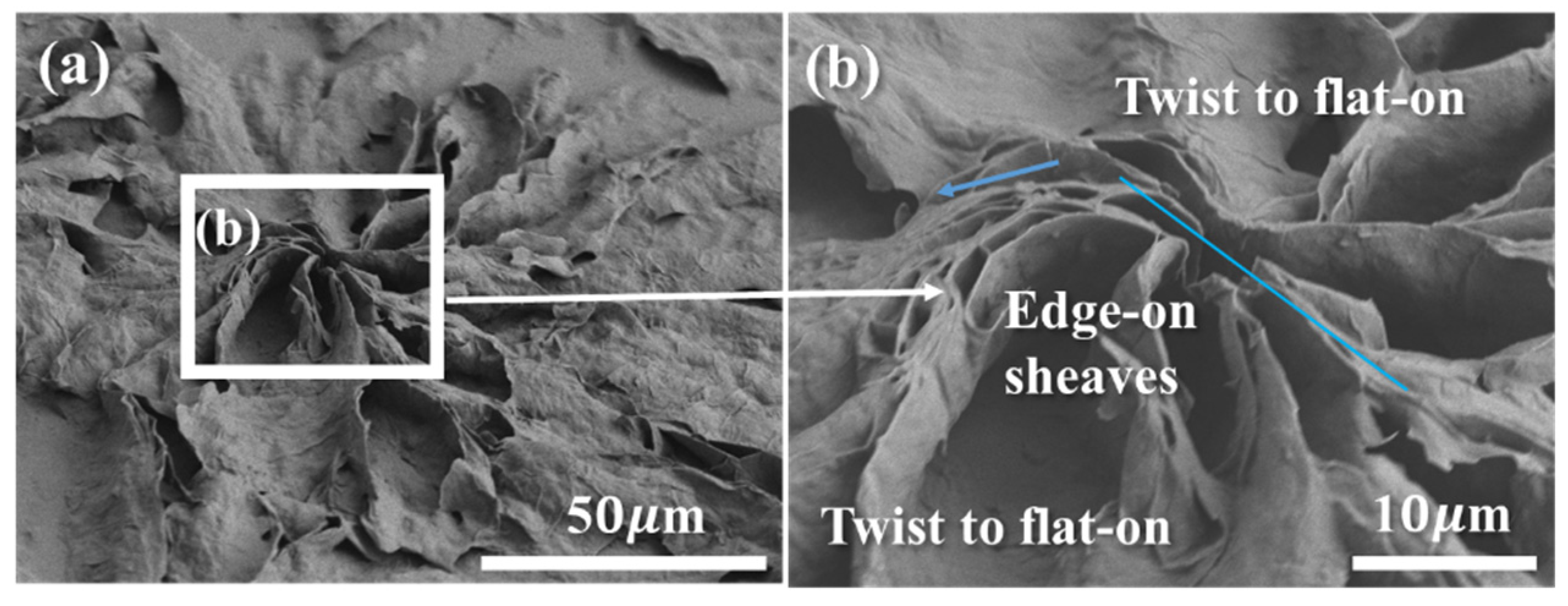
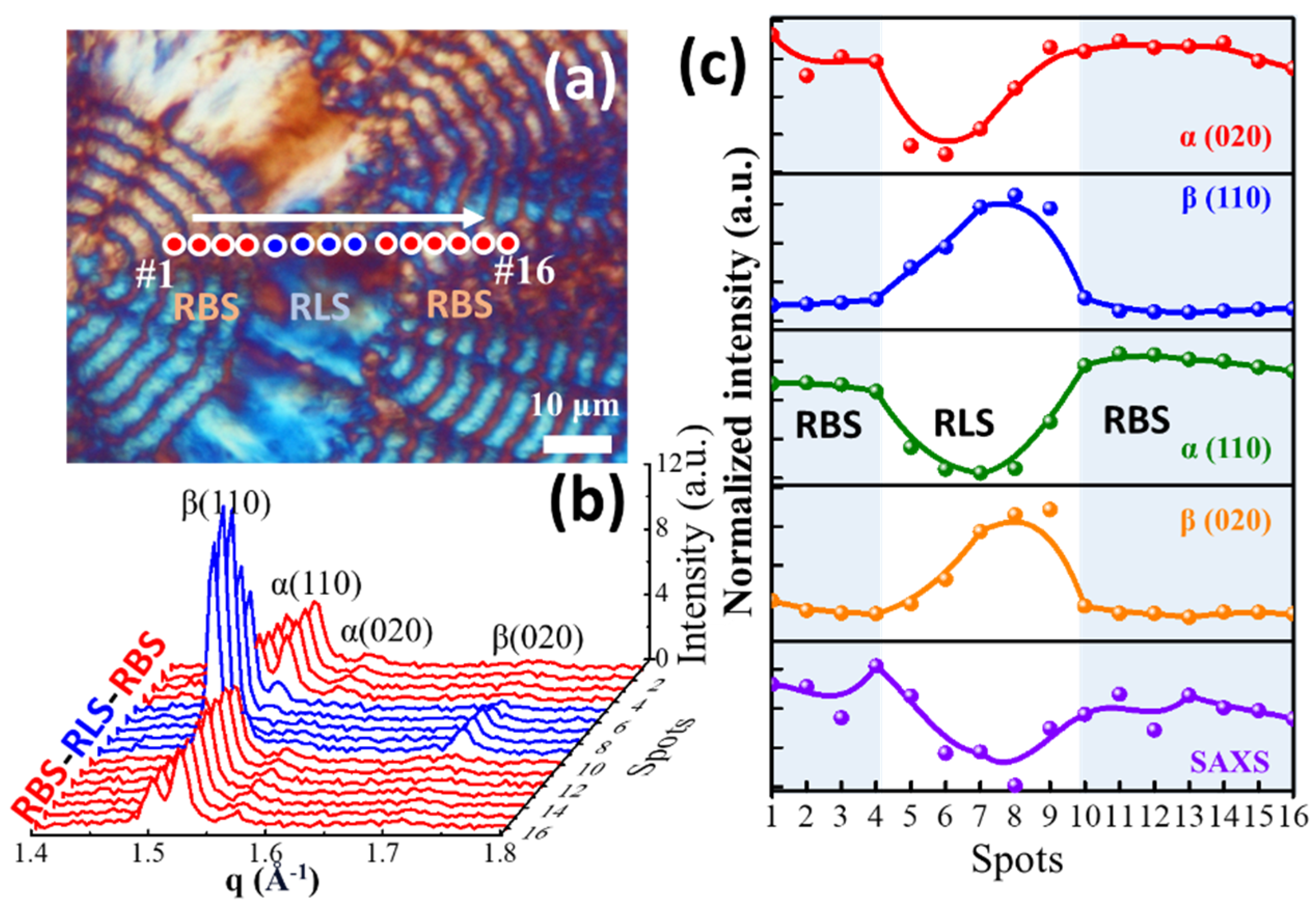
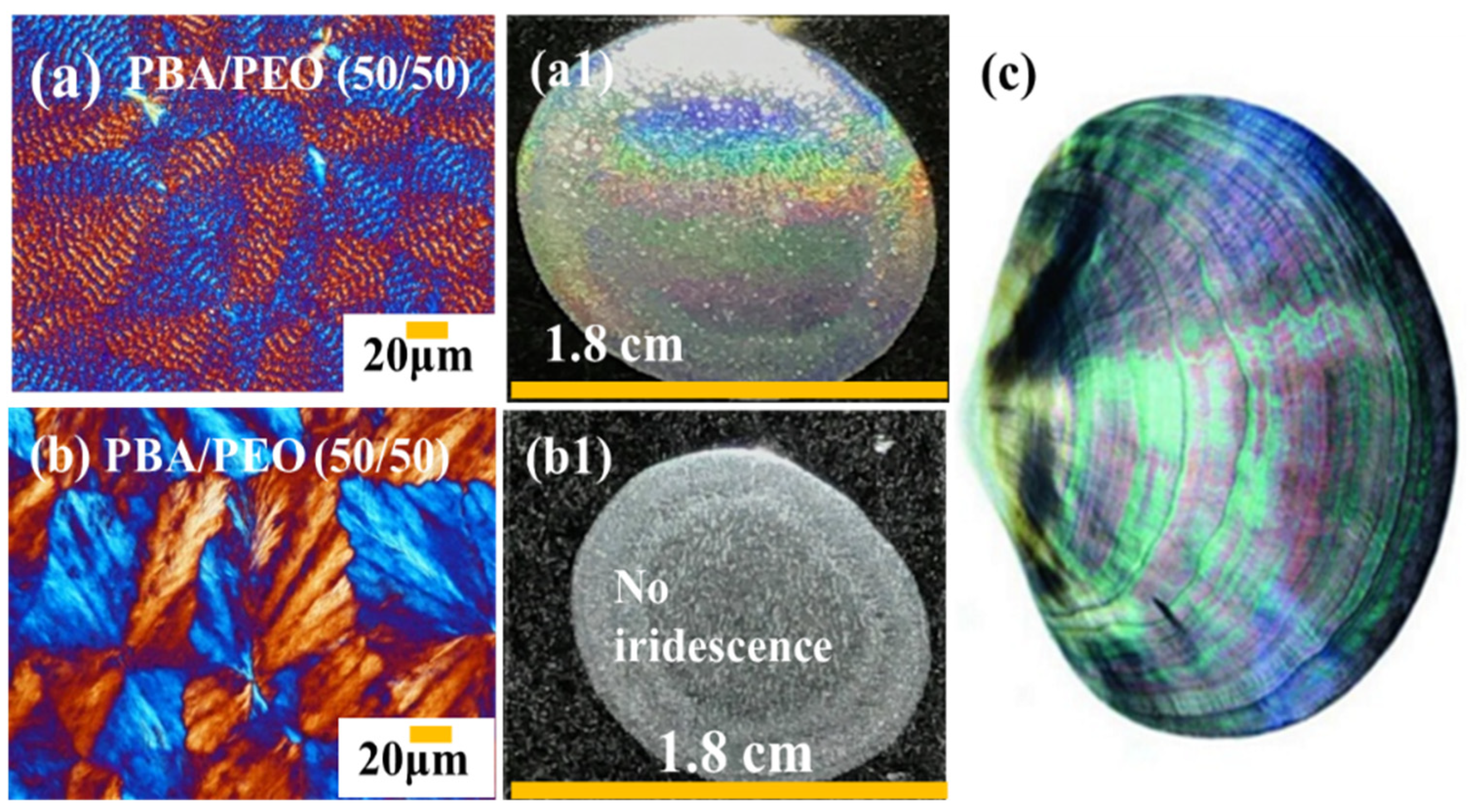
Disclaimer/Publisher’s Note: The statements, opinions and data contained in all publications are solely those of the individual author(s) and contributor(s) and not of MDPI and/or the editor(s). MDPI and/or the editor(s) disclaim responsibility for any injury to people or property resulting from any ideas, methods, instructions or products referred to in the content. |
© 2025 by the authors. Licensee MDPI, Basel, Switzerland. This article is an open access article distributed under the terms and conditions of the Creative Commons Attribution (CC BY) license (https://creativecommons.org/licenses/by/4.0/).
Share and Cite
Nagarajan, S.; Chang, C.-I.; Lin, I.-C.; Chen, Y.-S.; Su, C.-C.; Lee, L.-T.; Woo, E.M. Microbeam X-Ray Investigation of the Structural Transition from Circularly Banded to Ringless Dendritic Assemblies in Poly(Butylene Adipate) Through Dilution with Poly(Ethylene Oxide). Polymers 2025, 17, 2040. https://doi.org/10.3390/polym17152040
Nagarajan S, Chang C-I, Lin I-C, Chen Y-S, Su C-C, Lee L-T, Woo EM. Microbeam X-Ray Investigation of the Structural Transition from Circularly Banded to Ringless Dendritic Assemblies in Poly(Butylene Adipate) Through Dilution with Poly(Ethylene Oxide). Polymers. 2025; 17(15):2040. https://doi.org/10.3390/polym17152040
Chicago/Turabian StyleNagarajan, Selvaraj, Chia-I Chang, I-Chuan Lin, Yu-Syuan Chen, Chean-Cheng Su, Li-Ting Lee, and Eamor M. Woo. 2025. "Microbeam X-Ray Investigation of the Structural Transition from Circularly Banded to Ringless Dendritic Assemblies in Poly(Butylene Adipate) Through Dilution with Poly(Ethylene Oxide)" Polymers 17, no. 15: 2040. https://doi.org/10.3390/polym17152040
APA StyleNagarajan, S., Chang, C.-I., Lin, I.-C., Chen, Y.-S., Su, C.-C., Lee, L.-T., & Woo, E. M. (2025). Microbeam X-Ray Investigation of the Structural Transition from Circularly Banded to Ringless Dendritic Assemblies in Poly(Butylene Adipate) Through Dilution with Poly(Ethylene Oxide). Polymers, 17(15), 2040. https://doi.org/10.3390/polym17152040







